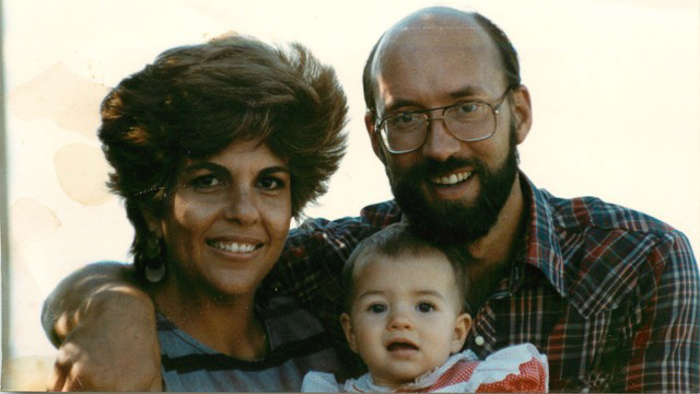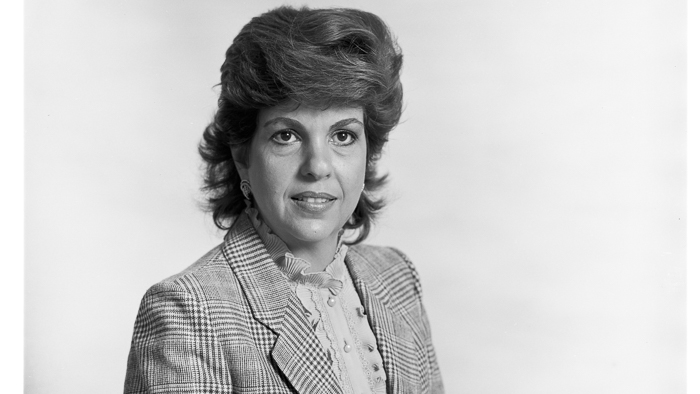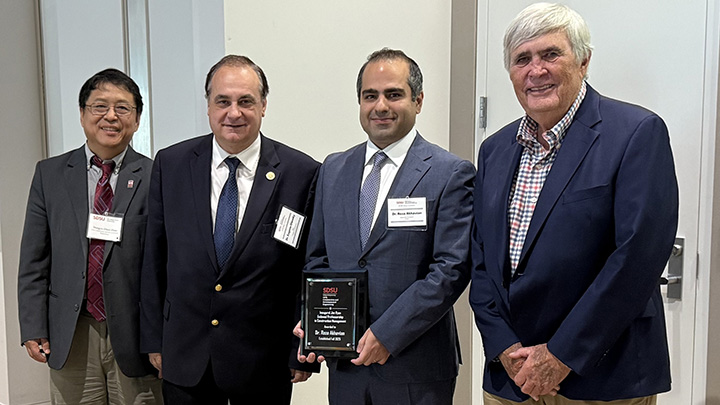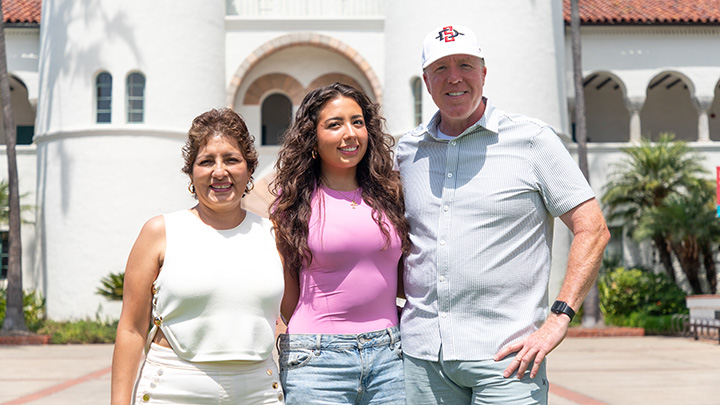In 1986, several San Diego State University mathematics professors joined forces to investigate ways to boost students’ results in the classroom, and train teachers on more effective instructional approaches.
They formed the Center for Research in Mathematics and Science Education (CRMSE), an interdisciplinary research center dedicated to studying math teaching and learning. Located off Alvarado Road, CRMSE today remains a strong collaboration between the College of Science’s Mathematics Department and the College of Education’s School of Teacher Education.
One of the center’s first faculty members was Alba Gonzalez Thompson, a trailblazing educator whose substantial legacy is being honored through a new endowment at CRMSE.
It’s an SDSU story that goes back 45 years, but still resonates for many.
A K-12 teacher with a freshly earned doctorate and an infant daughter, Ivonne, Gonzalez Thompson was offered a job teaching bilingual mathematics education in the School of Teacher Education in 1980. Recognizing their talents, the mathematics department quickly found a position for her husband, Pat Thompson, as well.
Gonzalez Thompson made waves in her field as an internationally renowned presenter, member of several academic committees, and researcher who explored vanguard topics in math education. Her findings led to a number of influential papers on mathematical reasoning and teaching that helped reform the nation’s math curricula and SAT math exam, and were cited in thousands of other works by researchers around the world.
A Revolutionary Researcher
At the time, studying how to teach math was a new phenomenon. The accepted practice involved getting students to memorize a series of facts and steps to solve problems.
Gonzalez Thompson looked beyond this black-and-white view of education. Her research showed students are better equipped to handle a range of problems when they have a deeper, conceptual understanding of the material.
CRMSE director Bill Zahner knew of Gonzalez Thompson before he joined the math faculty. He even used her paper “Calculational and Conceptual Orientations in Teaching Mathematics” for his master’s thesis.
“She and her collaborators were really ahead of their time,” Zahner said. “At a period where there was a pushback against teaching for understanding, they were holding the line on that idea and researching how to do that well.”
A revolutionary idea at the time, there is copious evidence today supporting teaching for understanding. Zahner explains when students follow steps they don’t understand and arrive at a point where they are unsure what to do next, they resort to guessing. However, when students are aware of why they have to follow each step and where each step leads, they are able to reason their way through more difficult problems and are better able to troubleshoot when they get stuck.
Over her career, Gonzalez Thompson generated over $2 million in National Science Foundation (NSF) grants to conduct transformational education research. She was not only one of just a few women in mathematics at the time, she also blazed new trails as the first Latina to join the math department. A native of Cuba, Gonzalez Thompson was expelled from the University of Havana for rejecting the Castro regime. She later moved to the U.S. and became a citizen on Independence Day in 1976.
"She had female students in Cuba tell her that just her presence changed their lives and their sense of what they could do," said Randy Philipp, professor of math education who also remembers Gonzalez Thompson as a perfectionist who cared deeply about her students and colleagues.
"One of the things about Alba that was always extraordinary to me was that she held high expectations for her students and held them to it," he added. "And it was the same at CRMSE — but at the same time, I felt like she loved us."
Hallmark of the CRMSE Community
 Open the image full screen.
Open the image full screen.The Gonzalez Thompsons spent a stint teaching at Illinois State University before returning to SDSU in 1990 as a family of four following the birth of their second daughter, Nicole. This time, Gonzalez Thompson joined the College of Sciences as a mathematics professor, where she became a mentor to many students and continued her innovative research at CRMSE.
The center not only bred impactful research but also great friendships among its close-knit group of educators. Doug McLeod is an SDSU professor emeritus of mathematics who helped found CRMSE. He and his wife, Sue, recently retired from UC Santa Barbara as Research Professor and Distinguished Scholar, met Gonzalez Thompson in 1980 and described her as a very strong person with an outgoing, bubbly personality. The two families quickly became close.
“The whole family was an important part of our community at CRMSE,” said McLeod. “We saw Alba as a leader. We were all looking forward to the days when she would be elected to the director position and other honors, but sadly, that didn't happen.”
In 1996, Gonzalez Thompson died suddenly at the age of 49, shortly after returning from an international conference where she was an esteemed speaker.
“We loved Alba. It's so hard to lose a young friend, a person who has such a good future ahead of her in the field,” McLeod said. “She was such an impressive individual that when we lost her, it was just such a tragedy that we were all in shock. It was so difficult to manage the grief.”
Lisa Clement Lamb, now a professor of mathematics education at SDSU, was Gonzalez Thompson’s first doctoral student.
"She invited me into her home on multiple occasions," recalls Lamb, who said Gonzalez Thompson’s passing hit her hard. "She was an extraordinary gardener, so we would sit out on her back patio. Pat was also on my committee. I had no idea as a graduate student, these were rock stars in the math ed field; they were just my professors at San Diego State. She made me feel really cared for, but in a really demanding way."
Honoring A Legacy
 Open the image full screen.
Open the image full screen.The McLeods recently created an endowment for CRMSE in Gonzalez Thompson’s name. They feel this gift is the best way to honor their beloved friend and colleague for her contributions to the field of math education and to the lives around her, while supporting the center, which was pivotal for them all.
Over the years, CRMSE has evolved to include all areas of STEM education, examining the cognitive mechanisms behind learning subjects from chemistry to fractions. Instructors involved in CRMSE develop new frameworks for measuring these mechanisms, producing valuable insight on how students learn various topics and, therefore, the most effective ways to teach them. This is part of CRMSE’s translational work, applying lessons learned to professional development programs that teach teachers strategies supported by novel research.
Candidates from SDSU and the University of California San Diego’s joint doctoral program in math and science education (MSED), which was established in 1992, are also heavily involved in CRMSE. They, along with the center’s 27 affiliated faculty, bring in $2 to $5 million of new grants each year, primarily from the NSF. This produces $10-$20 million in active projects at any given time. With CRMSE providing a valuable research tool for MSED students, SDSU landed among this year’s top 50 schools for graduate education programs nationwide, its highest ever ranking in this category.
Zahner says CRMSE is “deeply grateful” for the endowment, which will contribute to growing the MSED program and ongoing efforts related to diversity, equity and inclusion across the center. In particular, it will expand student educational resources by funding travel to conferences and professional development experiences.
Today, Gonzalez Thompson’s daughters follow in their mother’s footsteps, with Ivonne balancing life as a mom while exercising a shared love for numbers through a career on Wall Street, and Nicole teaching anthropology at UC Santa Barbara and traveling around the world to conduct research.
On June 23, CRMSE will host an event honoring Gonzalez Thompson’s life and enduring impact to the university and celebrating the new endowment made in her honor.



